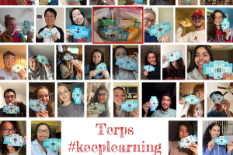News Story
BIOE121 Students #KeepLearning with Take-Home Laboratory Kits

BIOE121 Class
Shortly before the University of Maryland announced its shift to virtual courses for the remainder of the Spring 2020 semester, Fischell Department of Bioengineering (BIOE) Senior Lecturer Angela Jones, BIOE 121 (Biology for Engineers Laboratory) instructor, decided to create a series of innovative experiments that her students could perform at home.
“As it was becoming more and more clear that we might not come back after spring break, I started thinking about what students could possibly do at home, safely, and still gain relevant knowledge,” said Jones. “I had a couple of kitchen-chemistry/biology experiments on the back of my mind. Thus, I spent time demoing the experiments I had in mind for them to perform before spring break ended to confirm it was something they could do at home. Then I made purchases of all they would need to implement these experiments.”
BIOE Academic Program Specialist Rachel Chang, Master of Engineering (M.Eng.) student Naomi Feldman, and graduating senior Kurt Kunkel, and Jones spent a day assembling the kits for students.
The class’s first at-home experiment focused on exploring enzymes; it made use of pineapple juice, gelatin, a thermometer, and microcentrifuge tubes. Students changed the temperature of the pineapple juice by incubating it in tap water that had been microwaved for various lengths of time. This permitted them to observe the way that enzymes are denatured as temperature increases. The bromelain enzyme in the pineapple juice naturally degrades the gelatin proteins that make gelatin gel. Thus, the gelatin would remain liquid if the bromelain was not denatured (low temperatures) or gel if the bromelain was denatured (high temperatures).
I am excited to see how (the students) rise to this challenge of designing an experiment given what they have at home. Engineers are problem-solvers after all!
BIOE Senior Lecturer Angela Jones
For their second assignment, BIOE 121 students were tasked with constructing paper microscopes, known as Foldscopes, and collecting samples from in and around their homes. Students then used camera phones and Foldscopes to take microscopic images.
The next at-home experiment will focus on yeast microscopy. Students will use their Foldscopes to count the number of CO2 bubbles produced when baker's (brewer's) yeast (saccharomyces cerevisiae) is "cultured" with varying solutions of sucrose. This allows the students to then quantify the relative rates of bubbles produced to examine the impact of sucrose concentration on CO2 production.
For their fourth and final at-home assignment, BIOE 121 students will design and execute their own experiment. The course traditionally culminates with an opportunity for students to design their own experiment using the resources and tools they have acquired throughout the semester. Typically, experimental design, execution, and repetition takes place over the course of three weeks.
“There are so many experiences they gain from designing a well-controlled experiment, ensuring they're measuring what they think they're measuring, and then analyzing something they're interested in learning,” said Jones. “It was a priority to me to retain this despite the stay-at-home order. I am excited to see how they rise to this challenge of designing an experiment given what they have at home. Engineers are problem-solvers after all!”
Published April 23, 2020









